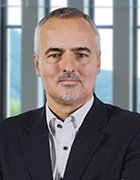How AI-driven digital ecosystems can improve sustainability
In this podcast, Schneider Electric CDO Peter Weckesser says integrating AI, IoT sensors and digital twins can improve energy efficiency to curb global warming.
The sustainability products of ERP software vendors mostly focus on data collection and reporting requirements of environmental, social and governance (ESG) policies. They're typically not designed to directly control business processes that use resources and affect the environment -- that's more the purview of specialized technology for monitoring and controlling the resource use of buildings, production lines, machinery and other energy-intensive systems.
This ground-level IT infrastructure is getting smarter, thanks in large part to synergies between AI, IoT and digital twins. And it's increasingly integrated with ERP and other front-end applications to create a digital ecosystem that helps organizations plan and execute reductions in resource use -- and back up their ESG claims with action.
In this episode of Enterprise Apps Unpacked, Peter Weckesser, chief digital officer of Schneider Electric, explains how these digital technologies can improve efficiency and sustainability while enabling growth. He also discusses the latest developments in AI and IoT, lessons from his experiences implementing sustainability technology and whether tech-driven efforts have a realistic hope of addressing climate change.
From the shop floor to the top floor
 Peter Weckesser
Peter Weckesser
Schneider Electric makes hardware and software for energy management, intelligent automation, and safety for homes, factories and other buildings. It is both a user and seller of its products, and Weckesser's role at the company reflects that duality.
He leads Schneider Electric's internal digital transformation strategy and oversees the EcoStruxure IoT platform, which is the foundation for many of its industrial automation, building management and sustainability products. He also leads efforts to apply AI in both domains.
Weckesser explained the company's energy-efficiency technology.
"It's a whole set of technologies that have to work together to deliver sustainability outcomes," all connected by vertical integration "from the shop floor to the top floor," he said.
There's software for designing physical assets, such as electrical systems, and creating digital twins of those systems. Data collected from IoT sensors is fed into a data repository that contains the digital twins and related information, along with analytics that are increasingly augmented with AI. He said the company has worked to break down silos and build an architecture that can take IoT data from a variety of sources, including third-party sensors, resulting in a centralized hub for managing energy data.
Other topics discussed in the podcast include the following:
- New capabilities enabled by generative and agentic AI.
- The sustainability technologies with the quickest ROI.
- Schneider Electric's work to optimize resource use in AI data centers.
- Whether using technology for sustainability strategies only adds to the tech industry's heavy use of natural resources.
David Essex is an industry editor who covers enterprise applications, emerging technology and market trends, and creates in-depth content for several TechTarget websites.






